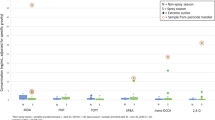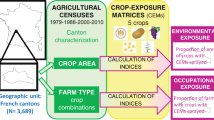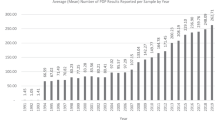Abstract
The aim was to develop quantitative estimates of farmers’ pesticide exposure to atrazine and to provide an overview of background levels of selected non-persistent pesticides among corn farmers in a longitudinal molecular epidemiologic study. The study population consisted of 30 Agricultural Health Study farmers from Iowa and 10 non-farming controls. Farmers completed daily and weekly diaries from March to November in 2002 and 2003 on pesticide use and other exposure determinants. Urine samples were collected at 10 time points relative to atrazine application and other farming activities. Pesticide exposure was assessed using urinary metabolites and diaries. The analytical limit of detection (LOD) ranged between 0.1 and 0.2 μg/l for all pesticide analytes except for isazaphos (1.5 μg/l) and diazinon (0.7 μg/l). Farmers had higher geometric mean urinary atrazine mercapturate (AZM) values than controls during planting (1.1 vs <LOD μg/g creatinine; P<0.05). AZM levels among farmers were significantly related to the amount of atrazine applied (P=0.015). Interestingly, farmers had a larger proportion of samples above the LOD than controls even after exclusion of observations with an atrazine application within 7 days before urine collection (38% vs 6%, P<0.0001). A similar pattern was observed for 2,4-D and acetochlor (92% vs 47%, P<0.0001 and 45% vs 4%, P<0.0001, respectively). Urinary AZM levels in farmers were largely driven by recent application of atrazine. Therefore, the amount of atrazine applied is likely to provide valid surrogates of atrazine exposure in epidemiologic studies. Elevated background levels of non-persistent pesticides, especially 2,4-D, indicate importance in epidemiologic studies of capturing pesticide exposures that might not be directly related to the actual application.
This is a preview of subscription content, access via your institution
Access options
Subscribe to this journal
Receive 6 print issues and online access
$259.00 per year
only $43.17 per issue
Buy this article
- Purchase on Springer Link
- Instant access to full article PDF
Prices may be subject to local taxes which are calculated during checkout
Similar content being viewed by others
References
Alavanja M.C., Sandler D.P., McMaster S.B., Zahm S.H., McDonnell C.J., Lynch C.F., Pennybacker M., Rothman N., Dosemeci M., Bond A.E., and Blair A. The Agricultural Health Study. Environ Health Perspect 1996: 104: 362–369.
Barr D.B., Panuwet P., Nguyen J.V., Udunka S., and Needham L.L. Assessing exposure to atrazine and its metabolites using biomonitoring. Environ Health Perspect 2007: 115 (10): 1474–1478.
Curwin B.D., Hein M.J., Sanderson W.T., Barr D.B., Heederik D., Reynolds S.J., Ward E.M., and Alavanja M.C. Urinary and hand wipe pesticide levels among farmers and nonfarmers in Iowa. J Expo Anal Environ Epidemiol 2005b: 15 (6): 500–508.
Curwin B.D., Hein M.J., Sanderson W.T., Nishioka M.G., Reynolds S.J., Ward E.M., and Alavanja M.C. Pesticide contamination inside farm and nonfarm homes. J Occup Environ Hyg 2005a: 2: 357–367.
Gilman S.D., Gee S.J., Hammock B.D., Vogel J.S., Haack K., Buchholz B.A., Freeman S.P., Wester R.C., Hui X., and Maibach H.I. Analytical performance of accelerator mass spectrometry and liquid scintillation counting for detection of 14C-labeled atrazine metabolites in human urine. Anal Chem 1998: 70 (16): 3463–3469.
Hines C.J., Deddens J.A., Tucker S.P., and Hornung R.W. Distributions and determinants of pre-emergent herbicide exposures among custom applicators. Ann Occup Hyg 2001: 45: 227–239.
Hornung R.W., and Reed L.D. Estimation of average concentration in the presence of nondetectable values. Appl Occup Environ Hyg 1990: 5: 46–51.
Kim S., Vermeulen R., Waidyanatha S., Johnson B.A., Lan Q., Rothman N., Smith M.T., Zhang L., Li G., Shen M., Yin S., and Rappaport S.M. Using urinary biomarkers to elucidate dose-related patterns of human benzene metabolism. Carcinogenesis 2006: 27: 772–781.
Kleinbaum D.G., Kupper L.L., Muller K.E., and Nizam A. Applied Regression Analysis and Multivariable Methods, 3rd edn. PWS-KENT Publishing Company, Boston, USA, 1998.
Kromhout H., and Heederik D. Effects of errors in the measurement of agricultural exposures. Scand J Work Environ Health 2005: 31 (Suppl 1): 33–38.
Olsson A.O., Baker S.E., Nguyen J.V., Romanoff L.C., Udunka S.O., Walker R.D., Flemmen K.L., and Barr D.B. A liquid chromatography–tandem mass spectrometry multiresidue method for quantification of specific metabolites of organophosphorus pesticides, synthetic pyrethroids, selected herbicides, and DEET in human urine. Anal Chem 2004: 76: 2453–2461.
Preller L., Kromhout H., Heederik D., and Tielen M.J. Modeling long-term average exposure in occupational exposure-response analysis. Scand J Work Environ Health 1995: 21: 504–512.
Rappaport S.M. Assessment of long-term exposures to toxic substances in air. Ann Occup Hyg 1991: 35: 61–121.
Stewart P.A., Prince J.K., Colt J.S., and Ward M.H. A method for assessing occupational pesticide exposures of farmworkers. Am J Ind Med 2001: 40: 561–570.
Vermeulen R., De Roos A.J., Bakke B., Blair A., Hildesheim A., Pinto L., Gillette P.P., Lynch C.F., Allen R.H., and Alavanja M.C. A study on immunological responses to exposures encountered in corn farming. J Biochem Mol Toxicol 2005: 19: 172.
Acknowledgements
This work was supported by the Intramural Research Program of the National Institutes of Health, National Cancer Institute and funding from the Environmental Protection Agency, USA. We thank Cynthia J Hines (National Institute for Occupational Health and Safety), Jane Hoppin (National Institute of Environmental Health Sciences), and Kent Thomas (US Environmental Protection Agency), for useful comments on an earlier version of this article.
Author information
Authors and Affiliations
Corresponding author
Additional information
Disclaimer
The views expressed are those of the authors and do not necessarily represent the official policy of US Environmental Protection Agency and the Centers for Disease Control and Prevention.
Appendix A
Appendix A
Rights and permissions
About this article
Cite this article
Bakke, B., De Roos, A., Barr, D. et al. Exposure to atrazine and selected non-persistent pesticides among corn farmers during a growing season. J Expo Sci Environ Epidemiol 19, 544–554 (2009). https://doi.org/10.1038/jes.2008.53
Received:
Accepted:
Published:
Issue Date:
DOI: https://doi.org/10.1038/jes.2008.53
Keywords
This article is cited by
-
Exposure to pesticides and breast cancer in the city of Petrópolis, Brazil
Environmental Science and Pollution Research (2023)
-
Biomonitoring of chlorpyrifos exposure and health risk assessment among applicators on rice farms in Ghana
Environmental Science and Pollution Research (2018)



